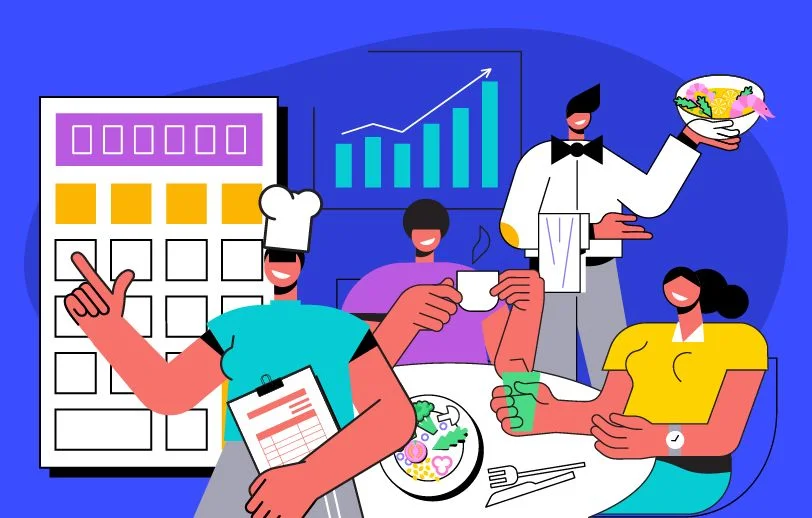As a restaurant owner, restaurant employee turnover is probably one of your most expensive problems.
The average turnover rate in the restaurant industry has been notably high, varying significantly over the years due to factors like seasonality and economic conditions. Historically, the turnover rate was about 71.6% from 2013 to 2019. However, it soared to 132% in 2020 due to the pandemic's impact on the industry. As of the most recent data, the turnover rate has been reported around 79.6% over the past decade, indicating a slight improvement but still reflecting high turnover relative to other industries.
In the quick-service restaurant industry, employee turnover rates are even higher, often ranging between 130% and 150% according to industry reports.
According to a research, the average cost of employee turnover for a standard front-line employee is estimated to be approximately $5,864 per person.
It’s true what they say: it’s hard to find good employees. However, ever since the pandemic, restaurant workers are quitting their jobs.
According to a research, here are top reasons why restaurant employees quit their jobs:
- 32% lack growth opportunities
- 22% pay/benefits
- 20% poor job fit
- 17% workplace culture
- 7% scheduling issues
What can you do to fix restaurant employee turnover?
Fortunately, there’s quite a lot.
These smart retention strategies can help you address the top reasons for your high turnover rate so you can keep your employees engaged and meet your long-term goals.
Top Strategies To Reduce Staff Turnover In Restaurant Industry
Your restaurant staff work in a challenging industry.
Hospitality and service jobs are hard work, and for most people, the pay is a major challenge. Restaurant workers have the highest rate of uninsured and underinsured workers in the US. Your employees are under a lot of stress, and burnout is a real risk.
Addressing your turnover problem is going to take some investment. Some of that investment is monetary, and some will require time and attention instead of cash.
As you build your retention strategy, remember that your goal is to help your employees make more money and work in a more pleasant environment. Keep them in mind and you’ll be more successful at reducing turnover.
Here are 7 impactful retention strategies to get started.
1. Retention Starts With the Job Description
One of the keys to retaining your employees is setting the right expectations before they even apply for the job.
A good restaurant job description should do all of these things:
- State base pay and explain pay structure
- Describe the skills needed to succeed
- Talk about company values and culture
- Showcase opportunities to advance
The hiring and interview process sets the tone for the working relationship. In your hiring process, make sure that candidates know what success looks like so they can get started on the right foot.

2. Don’t Stop at Onboarding
Often, new employees don’t get the training they need. That’s a great place to start, but don’t stop at onboarding.
Ongoing training programs help your team members succeed and meet long-term goals. By offering additional training, you prove that you care about your employees and want them to stay with you as they grow.
Tailor your training to teach employees the new skills they’ll need to advance within your system.
Do you need more restaurant managers? Offer opportunities to learn about restaurant financial metrics and operations.
Looking for your servers to create a stellar atmosphere for your dine-in guests? Sponsor courses on how to succeed in the hospitality industry.
Training doesn’t have to happen on the job for it to succeed. You can send your employees to classes, workshops, or even conferences to level up their skills. You’ll benefit from their new competencies and they’ll have a chance to earn more. It’s a win-win.
3. Help Your Staff Make More Money
Margins in the restaurant industry can be tight. It’s hard to offer higher pay if it means raising prices and losing your competitive edge.
Logically, the first step to help your employees make more money is figuring out how you can increase profits. There are two ways to do that — increasing revenue and cutting expenses.
Yes, that’s easier said than done, but you can do it. Reducing waste is one of the fastest ways to cut expenses, and you can do that with accurate forecasting tools for restaurants.
Another way to help your staff make more money is to schedule them more efficiently. Nobody likes to work a shift that’s over- or understaffed, and both of those problems cut into your teams’ tips. Competition for the most valuable shifts and tables can create tension within your team on top of that.
Use a smart restaurant scheduling tool like Lineup.ai to help you get the right people on the right shifts.
From there, you might consider pooling tips to make pay more fair across shifts and tables. Plus, the front-of-house staff and back-of-house workers should have equal chances to make more on a good night.
As you work on this, communicate with your team about what you’re doing and the results you’re after. They’re more likely to stick around through tough times when they know you’re working hard to help.
4. Offer Perks and Incentives That Make People Feel Appreciated
Lack of benefits is a major complaint for restaurant workers. They pay for their healthcare, child care, transportation, and often their uniforms and other work supplies out of pocket.
Even if you can’t afford group health insurance (check with a local insurance agent to ask about group rates for small businesses), you can still offer other incentives that are low cost to you and highly beneficial to your employees.
Traditional benefits like employer-sponsored insurance and retirement plans are the most in demand. Big corporate chain restaurants can afford to offer these benefits and more including tuition reimbursement, mental health counseling, and paid vacation time.
For independently owned restaurants, these types of perks are likely out of their price range.
Get creative and look for things you can offer. Ask around to see if you can get discounted group rates at childcare services, local gyms, or other in-demand services.
Offering free meals and discounted rates to certain close friends and family members may also be attractive.
5. Train Your Management Team in Leadership
A bad boss can quickly undo all the other work you’ve put in.
Restaurant managers may be great at operations, but not so effective at leadership.
If you’re hearing complaints about your employees being overworked, berated, or pushed past the point of exhaustion, it’s time to look at your management practices.
Empathetic, caring leaders can make a huge difference to high employee turnover. In general, most people would choose a pleasant work environment where they feel appreciated over an unpleasant environment where they make a little more money and have benefits.
Just like the ongoing training we mentioned earlier, you don’t have to do this on the job. It may be wise to enroll your managers in training courses that they take during the off-hours.
Check out the skills of a good restaurant manager.

6. Use the Right Tools
Nobody likes wasting time, and using the wrong tools is a huge waste of time.
Do you have a modern POS system? Are you using the right forecasting and scheduling software? What about your financial management tools and payroll system?
This also extends to your food service equipment. How is your kitchen running? Are people complaining about broken or outdated appliances?
The tools you use make a profound difference in your work efficiency and your stress levels. Find areas where you or your team are wasting time and effort, then look if there is a cost-effective upgrade that can free up their time to focus on more profitable activities.
Check out a list of restaurant management tools we've put together.

7. Work on Your Team Communication
Open the lines of communication before it’s too late. You can listen to complaints from employees who are still trying to make it work, or you can hear about the reasons someone quit after it’s too late to retain them.
Communication in a restaurant is a two-way street. You want your team to listen to you, but the first step is listening to them.
Accept anonymous feedback. There are plenty of online services and programs that are far more effective (and truly anonymous) than a suggestion box, but even a box is helpful. Your people are probably scared to tell you the ugly truth about what’s bothering them, and anonymity makes that much easier.
Once you get that information, act on it. At the very least, let everyone know that you got the information and talk about how you can help, even if it’s not a major change.
Most importantly, tell your entire team what’s going on. Share your big goals and the steps you’re all taking to get there. Allow everyone to feel included in the long-term goals and overall success of the restaurant.
Final Thoughts: Retention Is a Habit
High restaurant staff turnover isn’t something you fix once and forget.
That makes a lot of sense when you think about it. You want your staff members to stick around and stay engaged for the long term, so it’s only fair that your retention efforts are long-term, too.
Staffing is one of the big challenges of the restaurant business, but your healthy company culture and commitment to the well-being of your team will transform the way your team operates. It’s going to take time to see results, but it’s well worth it. Stick with it and watch your staffing issues fade.

The team at Lineup.ai is composed of seasoned professionals who hold deep insights into the unique challenges and pain points of the restaurant industry, and are equally skilled in artificial intelligence, machine learning, and data analytics. This fusion of expertise enables Lineup.ai to create cutting-edge AI solutions specifically tailored for the restaurant sector. The technical and analytical prowess of the team, combined with a deep understanding of the unique challenges faced by restaurants, forms the cornerstone of the company's innovation. The team at Lineup.ai also excels in communicating the benefits and applications of AI and machine learning to businesses, ensuring clients fully leverage the capabilities of these solutions.
More about the author